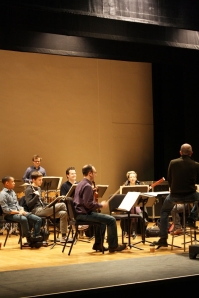
Approved emblem for the 1939 New York World’s Fair; Designer: unknown; Tempera on board; Museum of the City of New York; World’s Fair Board of Design Collection, 41.44.61
I didn’t grow up in New York, or even in the United States. So before Wednesday afternoon my sole point of reference for the world’s fairs of the thirties was Michael Chabon’s The Amazing Adventures of Kavalier and Clay, in which two characters enjoy a tryst in the middle of the Democracity exhibit at the Perisphere, the iconic globe at the centre of the New York World’s Fair of 1939-40.
Sammy Clay’s and Tracy Bacon’s romp is only a somewhat more erotic expression of what many New Yorkers may have felt at the time, according to Jessica Lautin, a post-doctoral curatorial fellow at the Museum of the City of New York: fascination, even enchantment, with the sleek vision of the future on display at Flushing Meadow, Queens. Succeeding four other expositions of the thirties and contemporaneous with a fifth in San Francisco, the New York World’s Fair bewitched some forty-five million spectators with its displays of slick cars, bullet-nosed trains, friendly domestic robots, home dishwashers, streamlined toasters, modular furniture, bakelite napkin rings, and amusement park-like rides meant to show off the car-filled, skyscraping cities of the future. On offer at the fair: a spectacular escape from the daily realities of the depression and Second World War, and a tantalizing sample of a factory-made, affordable, and consumable world to come. Small wonder (some) New Yorkers fell in love.
Until March 31, the MCNY is offering New Yorkers a chance to relive, and reexamine, the Fair’s historical moment. Materials from the world’s fairs of the thirties—Chicago (1933-4), San Diego (’35-6), Dallas (’36), Cleveland (’36-7), San Francisco (’39-40), and New York (’39-40)—are currently on display at the MCNY’s Designing Tomorrow exhibit, which Lautin and her curatorial team have adapted for the MCNY’s space and audience from the original exhibit at the National Building Museum in Washington, D.C.. Working under somewhat more cramped conditions, Lautin has made a virtue of necessity, grouping the exhibition materials thematically and housing them in rectilinear structures meant to evoke the Fair’s original pavilions. The MCNY’s exhibit also shines a particular light on the exhibition in Flushing Meadow, its place within its historical context, and its role in reshaping New York City: the construction turned The Great Gatsby’s “valley of ashes” into the current Flushing Meadows Park, while the Queens Museum now occupies the Fair’s New York City pavilion, the only building meant to outlast the exposition.

An illustrated rendering of a scene from The Middleton Family at the New York World’s Fair. The Middletons admire Moto-Man, the domestic robot of which the MCNY has an exact replica on display.
Chatting with me over coffee in the museum’s café, Lautin emphasized the seismic shifts in cultural territory that the Fairs inaugurated, changes that went beyond home dishwashers, cars for summer vacations, and furniture that families could move easily from room to room or house to house. The Fairs’ corporations like Ford and Westinghouse sold, and their spectators bought, a kind of political and economic citizenship: middle class, straight, white, and happily committed to purchasing their place in the world promised by the glossy exhibits. Westinghouse even produced a film, tellingly titled The Middleton Family at the New York World’s Fair: a dour anti-capitalist artist and a smart blond engineer, conveniently employed at the Westinghouse pavilion, fight for a woman’s affections. (The engineer wins; was that in doubt?) However transparently propagandistic, the film’s simple narrative has a seductive pull over its spectators, no less than the engineer’s over Babs Middleton, giving us aesthetic purchase on the middle(ton)-class married life on offer at the Fair.
There’s something both attractive and dangerous in this seduction, which Designing Tomorrow, with its glossy artifacts and the siren-sheen of its Moto-man replica, recreates for a modern museum-goer. However suspect the political and economic vision that the world’s fair sold to its spectators, critically examining the Fairs’ historical moment offers rewarding insights into the futures that the Fairs’ corporate backers promised and, decades later, fulfilled.
So while I wouldn’t gaze at the past’s future with rose-tinted goggles, don’t let latter-day cynicism keep you away: Designing Tomorrow is exhaustively researched, impeccably presented, and also buckets of fun. The exhibition runs until March 31, and students with valid CUID get in free through Passport to NY. For more materials and information, including this snazzy recreation of the Democracity exhibit, check out the exhibition’s Tumblr, designingtomorrow1939.tumblr.com. On March 11, E.L. Doctorow will be reading at the MCNY from his National Book Award-winning novel World’s Fair for $8 students, $12 general public.
–Gavin McGown, CC’13




















